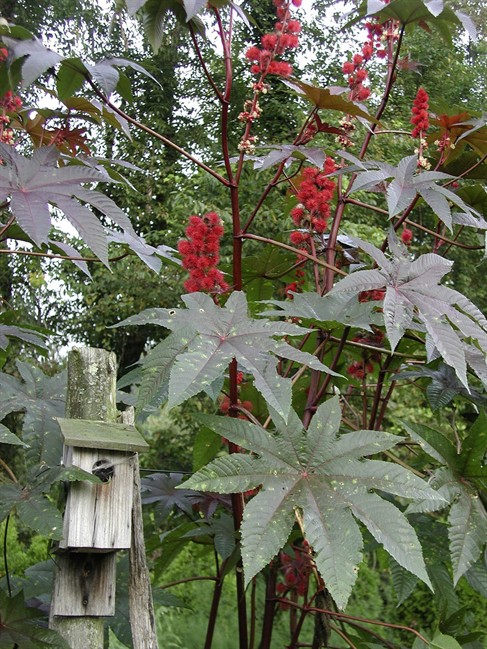Sweltering heat and bright sunlight do not a tropical garden make, even if many common garden plants, from marigolds to okra, do hail from the tropics.

That tropical look comes from lush, bold foliage.
Cannas provide such foliage, but get off to a slow start and need the right storage conditions if the tubers are to be carried through the winter. Some northern gardeners create instant tropicana by planting banana trees outdoors each summer and storing them through winter indoors, chilled into a semi-sleep.
My vote for the best plant to tropicalize a garden nook where winters are real is castor bean. It’s easy to grow and easy to carry on from year to year. And it grows quickly.
Castor bean is an annual, but don’t think that means it’s going to 60 centimetres by the end of the season. If you planted a castor bean seed last May, by now you’d have a shrub or small tree two or more metres high. The plant practically leaps out of the ground.
It does have an enormous thirst and appetite, so needs a rich soil and plenty of water.

Get daily National news
That great thirst probably gave rise to castor beans’ alleged ability to keep moles and malaria at bay. Both scourges thrive where there is an abundance of moisture – the moles for the earthworms that thrive in moist soils, and the malaria from the resultant mosquitoes. Castor bean plants can draw water up and out of the soil. Some gardeners try to chase off moles by dropping castor bean seeds into mole tunnels, or by watering castor oil into the ground.
LET THIS ANNUAL GO TO SEED
Around now, castor bean plants slow down as they channel some of their energy into making flowers and then seeds. Don’t nip out those flowers in an effort to get a plant to grow even bigger, as you might with some other annual grown for its foliage. The castor bean’s individual flowers are unimpressive, but they are massed in fuzzy stalks that complement the plant’s broad swaths of shiny foliage.
Those leaves can grow quite large, as much as one metre across. Among the many varieties of castor bean are ones with bronzy green leaves and red stems, ones with bright green leaves and white veins, and ones with blood red leaves and stems.
The one I planted this year has dark red leaves and stems. Like any worthy tropical plant, the large, lush leaves of castor bean – especially this dark red one – seem to cool things down even if you don’t actually sit in their shade.
THE DARKER SIDE OF CASTOR BEAN
And now for the down side of castor bean: no, not castor oil, that foul-tasting fluid that was forced down the throats of our grandparents when they were ill as children.
What is ominous is that every part of the plant except for the oil is extremely poisonous. Think twice before planting castor bean if young children are around. Alert any visitor to your garden that the plant is poisonous.
STILL, CASTOR’S AN ALL-AROUND BEAUTY
There is another reason for not nipping out those castor bean flowers, and that is so that the plant can make seeds. The spiny seed capsules – hot pink on my plants – are decorative in their own right. And the seeds are easy to save for planting the following spring, much easier than trying to keep canna tubers or banana trees indoors for winter.
Castor bean seeds also are quite pretty. Large and shiny, they often have interesting black and white or pink markings. Yet for all their eye appeal, remember that they are toxic. Ingesting even one could kill a child, so store them safe from curious young hands.







Comments